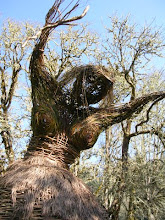The 20,000,000 year old Mystery Skull of Oregon
 |
| The old historical museum |
I remember visiting the Old Oregon Historical Museum at Gold Hill when I was a child. It was part of a group of roadside attractions that included the Oregon Vortex, Trees of Mystery, the Prehistoric Gardens (life-sized replicas of prehistoric animals), and if I recall correctly there was an Indian Village and a petting zoo, and whatever other enterprise that could thrown up near the Vortex, which was – and still is – a major attraction.
Studies suggest that there might be something weird at the site of the vortex – some magnetic influence, perhaps. (Supposedly aircraft compasses go haywire when flying over the site.) A lot of it is hyped-up though, a case of “don’t believe everything you see.”
 |
| Paul Bunyan and Babe at Trees of Mystery |
I haven’t been there for many, many years and apparently the museum has been refurbished to reflect the gold-mining era of the region. But when I was there it was a hodge-podge of weird and zany artifacts: two-headed sheep, various kinds of fetuses in jars, “mysterious objects” and so forth, along with legitimate pioneer and prospector memorabilia.
I don’t recall seeing the skull in this old postcard, and when I looked at it I was puzzled for a while. Then I realized that it is set on its “nose,” with the viewer looking at the palate with its “smiley” dentition depressions and the eye sockets from below – one of them deformed by pressure or crushing.
 |
| The caption reads: The Oregon Mystery Skull. Estimated to be more than 20,000,000 years old. Old Oregon Historical Museum, Gold Hill, Oregon |
Having solved that dilemma, the mystery remains – I haven’t identified what it is. The Oregon coastal area was, of course, once upon a time ocean floor so marine fossils are not uncommon, but then again the card does not identify where this object was found – and Oregon is rich in fossil remains. Educated guesses are welcome. One might estimate the size by the boards behind the skull, which appear to be approximately 8 inches wide.



